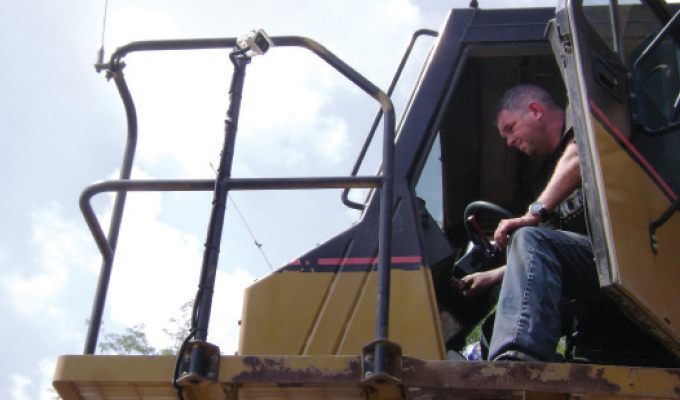By Alicia Delgado
Heavy-duty vehicle operators know that being safe on the job is an uncompromising priority. Not only do they have to ensure their own safety, but they are also focused on maintaining the safety of those around them—on top of managing their workload. It can be a lot to juggle in a world where attention to detail and the ability to focus on everything is vital. Unfortunately, a majority of operators have had to multi-task and divide their focus among their duties as software and surveillance hasn’t been viewed as a factor in ensuring a safe environment. However, investing in a surveillance system is in fact a necessary (not accessory) component of safe operations.
It’s important to recognize that a surveillance system is not a means for tracking operators but is instead used in the same way a home security camera is; to monitor what goes on outside of the house, or in this case—surrounding the vehicle. A surveillance system acts like a second pair of eyes on the vehicle that is chiefly focused on monitoring every aspect of the area.
Further, a surveillance system provides a multitude of other benefits as well, including improved personnel trainings, increased operational efficiency for both operators and field managers, heightened awareness, and better accountability.
PROTECTING OTHERS
Most heavy-duty vehicles vary in size, which requires multiple mounting points on each vehicle to ensure views are diverse and optimal for operators. This could include wide-angle exterior side and rear-view cameras. Placing cameras on all sides of the vehicle creates 360-degree views in the surrounding area and enhances awareness for the operator. When these camera placements are coupled with a viewing monitor, operators achieve maximum visibility as they maneuver the vehicle and are able complete their duties with confidence.
Increasing the awareness for operators creates better safety on the job as their focus and operations are streamlined. The operators no longer have to manage multiple viewpoints as they navigate the machinery—all points of view are visible on a mounted monitor; enabling them to easily ensure they’re free from hazard. This increase in awareness allows for a decrease in accidents or injuries as operators have improved their safety practices. Therefore, the vehicle and people in the surrounding area are better protected because the operator can see everything surrounding their vehicle. When cameras and the monitors provide 360-degree views for the operator, there is no chance to miss or not see an object or person in the area—everything is captured in the surveillance system.

OPERATIONAL EFFICIENCY
Embracing a surveillance solution creates opportunities for increased operational and administrative efficiency. The multiple camera views and monitor on the operator’s vehicle, allows them to work faster and more diligently on their duties as their caution has been somewhat relieved. It is important to note that operators will still have to practice safety; however, the system allows it to be achieved with more ease and confidence as they have gained heightened awareness. Therefore, they can manage their workload in a more effective and timely manner.
Many surveillance systems come with a live look-in feature that would serve as a great benefit for the field manager as they would no longer have to walk around the entire worksite to get an understanding of the duties that are in progress—all they would have to do is remotely log in to their video management system to gain a comprehensive view of all operations in real time. This frees up time for the manager to recognize areas where there could be room for improvement in a quicker and more effective manner. However, increased operational efficiency can still be achieved if the surveillance system doesn’t have live look-in, as the recorded footage is a valuable tool in evaluating the team’s operations and practices.
ENCOURAGING ACCOUNTABILITY
Recorded video footage is not only a vital tool for increasing operational efficiency but is also a useful resource for improving operator training and accountability. The recorded footage captures every detail on any incident that may take place, providing first-hand training for new and established operators. On the other hand, the footage can also be used to train operators about practices that are highly favored. Thus, regardless of whether the footage is used to show satisfactory or unfavorable moments, the first-hand view is more beneficial than a recounting of “what happened,” as no details will be forgotten or mis-told.
Likewise, the cameras enforce stronger operator accountability as their behaviors and the chain-of-events in any moment is documented. The awareness of the surveillance system enables operators to ensure they’re progressing through their duties with diligence and high attention to detail. More so, the recorded footage allows the operators to gain a better understanding of their own practices as they can visually see how their professional decisions or behaviors impact their duties.
About the author:
Alicia Delgado is the marketing content writer for Safety Vision, LLC. For more, visit www.safetyvision.com.
Modern Contractor Solutions, July 2020
Did you enjoy this article?
Subscribe to the FREE Digital Edition of Modern Contractor Solutions magazine.



